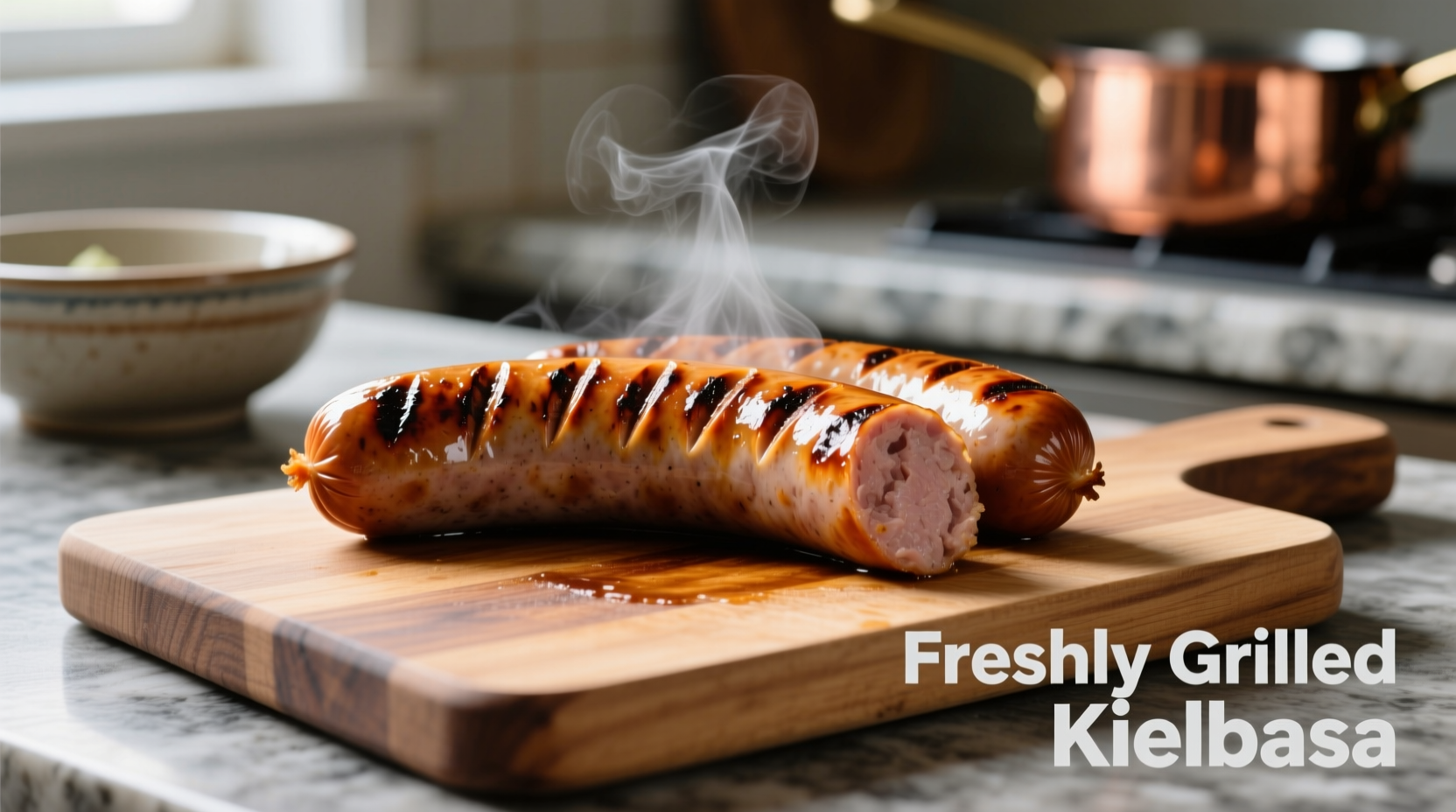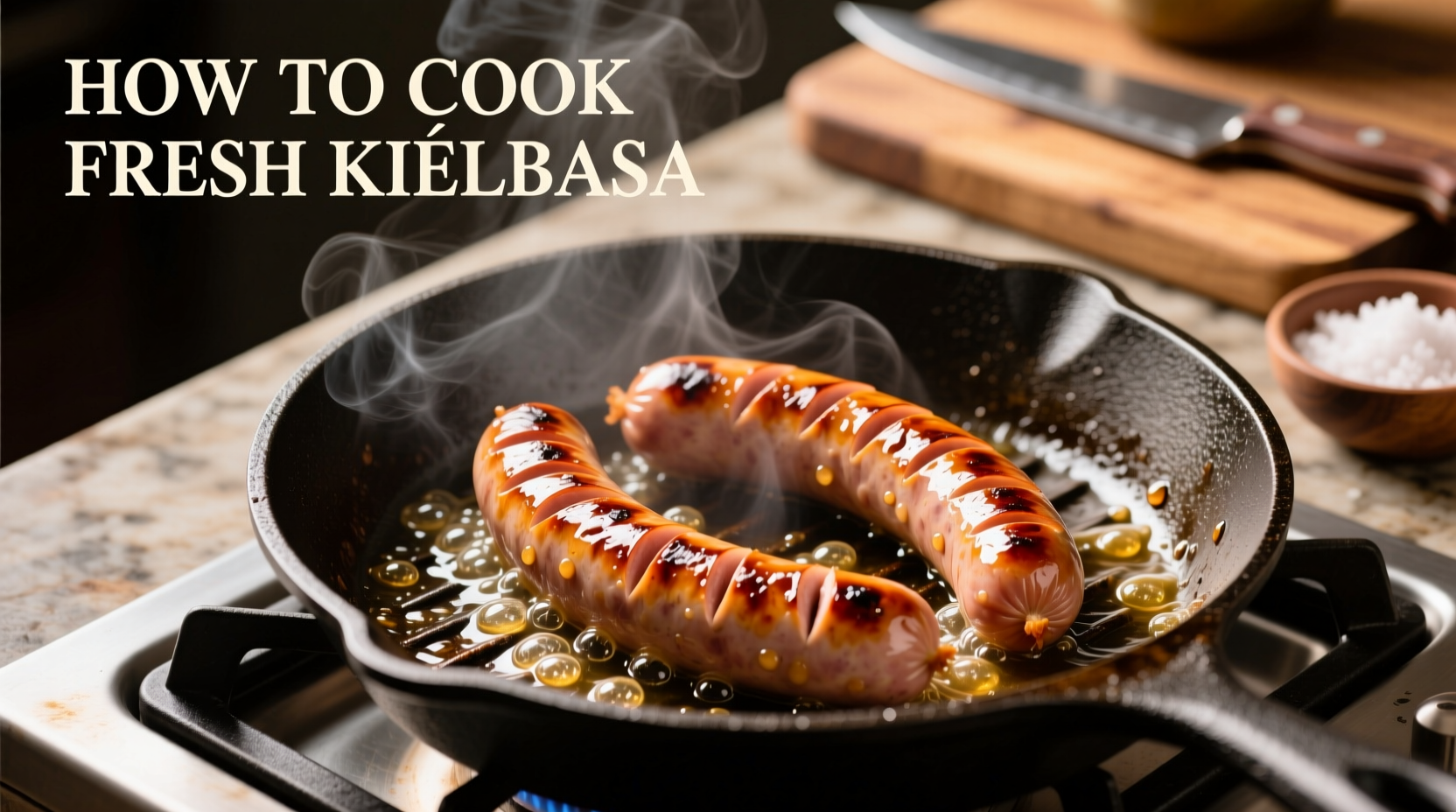Discover exactly how to cook fresh kielbasa to perfection with this comprehensive guide. Whether you're a first-time cook or looking to refine your technique, you'll learn the safest methods, ideal cooking times, and traditional serving suggestions that transform this Polish staple into a mouthwatering meal. No more guesswork about doneness or preparation methods—just reliable, professional-tested techniques that guarantee delicious results every time.
Understanding Fresh Kielbasa: What Makes It Different
Fresh kielbasa (also called biała kiełbasa in Polish) is raw, uncooked sausage that requires thorough cooking before eating. Unlike its smoked counterpart which is fully cooked during processing, fresh kielbasa contains raw pork and must reach a safe internal temperature to eliminate potential pathogens.
| Type of Kielbasa | Preparation Required | Storage Duration (Refrigerated) | Key Characteristics |
|---|---|---|---|
| Fresh Kielbasa | Must be fully cooked | 1-2 days | Raw, pale pink color, needs thorough cooking |
| Smoked Kielbasa | Ready to eat (can be heated) | 2-3 weeks | Brownish color, already cooked during smoking |
Essential Preparation Before Cooking
Before you start cooking, proper preparation ensures optimal results:
- Temperature check: Remove kielbasa from refrigerator 15-20 minutes before cooking to take the chill off
- Pricking technique: Use a sharp fork to make 4-5 shallow pricks along each sausage to prevent bursting
- Equipment readiness: Have a meat thermometer ready—this is non-negotiable for safe cooking
Four Reliable Methods for Cooking Fresh Kielbasa
Pan-Frying: The Quick & Crispy Approach
This method delivers beautifully browned exteriors with juicy interiors. According to USDA food safety guidelines, this technique ensures even heating throughout the sausage.
- Heat 1 tablespoon of oil in a heavy skillet over medium heat
- Add kielbasa and cook for 4-5 minutes until browned on first side
- Turn and cook another 4-5 minutes
- Reduce heat to medium-low, cover, and cook 3-5 more minutes
- Check internal temperature reaches 160°F (71°C)
Boiling: The Traditional Polish Technique
Boiling preserves moisture and is the most authentic preparation method. Polish culinary historians note this technique dates back to 14th century sausage preparation.
- Place kielbasa in large pot and cover with cold water by 1 inch
- Add 1 tablespoon vinegar to prevent casing splitting
- Bring to gentle simmer (do not boil vigorously)
- Cook for 20-25 minutes until internal temperature reaches 160°F
- Optional: Finish in skillet for 2-3 minutes to brown exterior
Grilling: Perfect for Outdoor Cooking
Grilling imparts delicious smoky notes. Food safety experts recommend this indirect heat method to prevent flare-ups that can char the exterior before interior cooks.
- Preheat grill to medium (350-400°F)
- Place kielbasa on cooler side of grill
- Cover and cook for 8-10 minutes
- Move to direct heat for 2-3 minutes to brown
- Rotate frequently for even cooking
- Verify internal temperature reaches 160°F
Oven-Baking: Hands-Off Method
Ideal when cooking multiple sausages or preparing side dishes simultaneously.
- Preheat oven to 375°F (190°C)
- Place kielbasa on baking sheet lined with parchment paper
- Bake for 20-25 minutes
- Turn halfway through cooking time
- Check internal temperature reaches 160°F
How to Verify Perfect Doneness
Never rely on color alone to determine if fresh kielbasa is cooked properly. The USDA Food Safety and Inspection Service emphasizes that visual cues can be misleading with sausages.
The only reliable method is using an instant-read thermometer inserted into the thickest part of the sausage. The internal temperature must reach 160°F (71°C) for safe consumption. At this temperature, the sausage will have:
- Firm but not hard texture
- No pink color in the center
- Clear juices when pierced

Traditional Serving Suggestions
In Poland, fresh kielbasa is traditionally served with:
- Cold mustard and horseradish
- Fresh rye bread or boiled potatoes
- Sauerkraut cooked with caraway seeds
- Simple side salad with vinegar dressing
For modern interpretations, try slicing cooked kielbasa and adding to:
- Bean and vegetable soups
- Pasta dishes with tomato sauce
- Breakfast hash with potatoes and peppers
Storage and Leftover Guidelines
Proper storage prevents foodborne illness. According to FDA guidelines, cooked kielbasa:
- Can be refrigerated for 3-4 days in airtight container
- Should be cooled within 2 hours of cooking
- Freezes well for up to 2 months
- Should be reheated to 165°F before serving leftovers
Common Mistakes to Avoid
Based on culinary research from European cooking traditions, these errors compromise both safety and quality:
- Skipping the thermometer: Visual doneness is unreliable with sausages
- High-heat cooking: Causes casing to burst before interior cooks
- Over-pricking: More than 5-6 pricks causes juice loss
- Immediate slicing: Let rest 3-5 minutes for juicier results
Why Temperature Matters: Food Safety Timeline
Understanding the science behind safe cooking temperatures helps prevent foodborne illness. This timeline shows what happens at different temperatures when cooking fresh kielbasa:
- 100°F (38°C): Bacteria begin to multiply rapidly
- 120°F (49°C): Trichinella parasites start to die
- 140°F (60°C): Salmonella begins to be destroyed
- 160°F (71°C): All harmful pathogens eliminated (safe minimum)
- 170°F+ (77°C+): Sausage becomes dry and tough
Conclusion
Cooking fresh kielbasa properly combines culinary tradition with modern food safety practices. By following these tested methods and verifying internal temperature, you'll enjoy delicious, safe results every time. Remember that patience with cooking temperatures yields juicier, more flavorful sausage than rushing the process. Whether you choose pan-frying, boiling, grilling, or baking, fresh kielbasa makes a satisfying meal when prepared correctly.











 浙公网安备
33010002000092号
浙公网安备
33010002000092号 浙B2-20120091-4
浙B2-20120091-4